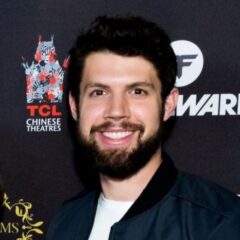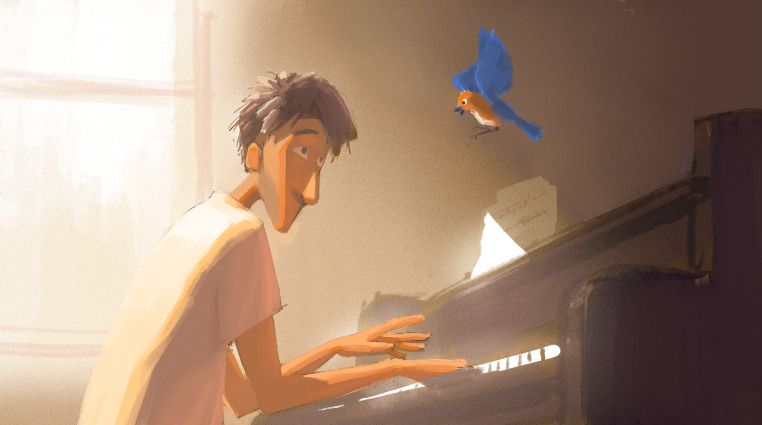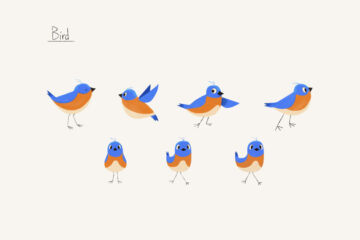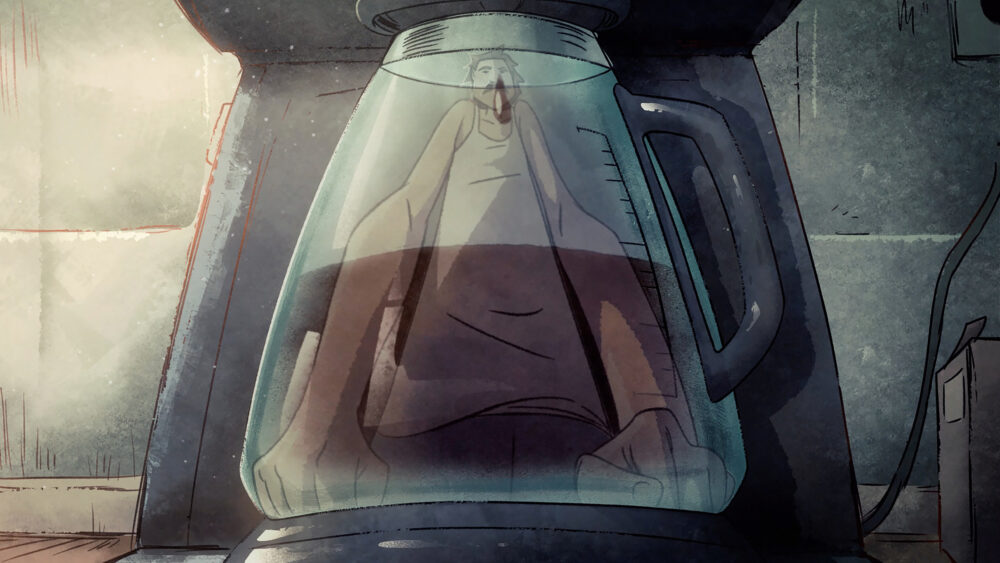In director John Henry Hinkel’s poignant new animated short Morning Joy, a recently widowed pianist learns to find happiness again after a friendly songbird pays him a visit. Henry, who also wrote the feature length adaptation of Tonko House’s The Dam Keeper and directed the short film Home, was kind enough to talk to us about his Oscar shortlist-qualified short and inspirations in a recent email interview.

Animation Magazine: Congrats on the recent success of your short. Can you tell us the inspiration for your short?
John Henry Hinkel: The seed for Morning Joy was first planted in 2017, when Ethan Pakchar, my creative partner on the film, approached me with the idea of a human and bird musical relationship. Initially, we developed a feature-length story about a young Joni Mitchell-type songwriter and a runaway songbird navigating the Greenwich Village folk scene of the 1960s. We had some interest from a few different production companies, but as things often go in Hollywood, the project never really went anywhere.
Flash forward to March 2020 and the COVID-19 pandemic. I was living in Los Angeles, Ethan was in New York, and the project was in the distant and nearly forgotten past. During one of our quarantine check-ins one morning, we both commented on waking up to the sounds of songbirds outside our windows. These creatures seemed so cheerful, oblivious to the depression and loneliness we were both feeling. This poetic disconnect, combined with our desire to create something we could see through to the end, inspired us to reinvent our earlier story into the short film you see today.
When did you start working on Morning Joy and how long did it take to make?
Ethan and I began writing the script in April 2020 and completed the film in September 2022, so it took roughly two and a half years to complete.

How many people worked on it with you and which animation tools were used?
We were fortunate to work with a number of brilliant collaborators on the film. The initial character sketches were created by Australian illustrator, Glenn Thomas. The storyboards and animatic were created by Nat Matthew, an incredibly talented illustrator in Texas who transformed my messy scribbles into coherent images. We also had the honor of working with longtime Disney storyboard artist Larry Scholl, who elevated these initial designs and injected some poignant moments of humor and pathos.

After meeting with a number of different animation companies, we ended up partnering with a Serbian company called Talesgate, run by longtime animator and 2D advocate Nemanja Gavrilovic, a.k.a. N.G. Nash. Under his guidance, the Talesgate team transformed the black-and-white storyboards into dynamic and tender works of art.
On the music side, Juilliard-trained pianist Vicky Chow played the main piano song, and recorder virtuoso Charlotte Barbour-Condini played the voice of the bird.
In total, we had roughly 35 people working on the film and used a combination of different software, including Toon Boom Storyboard Pro and Clip Studio Paint, as well as Photoshop and DaVinci Resolve.
What would you say were the toughest part of making this short?
One of the toughest parts of making any short film is securing the financing. Given that shorts are not inherently profitable, and that animation is quite expensive, we had to be strategic with our fundraising efforts. Fortunately, Film Independent, a non-profit arts organization, came onboard as our fiscal sponsor, which allowed us to accept tax-deductible donations and opened the door to the mysterious, yet lucrative, world of corporate matching. We also partnered with Kawai, a global piano company, to bring the film across the finish line.
What were the biggest lessons you learned from the process?
From 2017 to now, this project went through so many iterations and false starts, but Ethan and I never gave up. Despite profuse (and probably merciful) warnings from peers about the difficulties of animation, we dove headfirst into the challenges and embraced them. So, part one of the lesson is to find a partner (or team) that is just as crazy as you are about making something, and part two is to embrace the process and never give up, no matter how futile your efforts might feel. Dawn Staley, the women’s basketball coach at the University of South Carolina, has a great maxim that I think all artists should take to heart: “What is delayed is not denied.”
Can you talk a bit about your visual inspirations?
In making this film, I was deeply inspired by the visual style of Trevor Jimenez’s animated short film Weekends and the films of Sylvain Chomet. I also drew stylistic and pacing inspiration from Isao Takahata’s Gauche the Cellist, as well as from live-action films, such as Jim Jarmusch’s Paterson and Spike Jonze’s Her.
Who are some of your big animation idols?
Hayao Miyazaki will forever be my biggest animation idol. There is a unique visual poetry to his films that never fails to move me no matter how many times I watch them. I also look up to Daisuke “Dice” Tsutsumi and Robert Kondo, who I had the honor and privilege of working with on The Dam Keeper feature, and who inspired me to direct this film. Other influences include João Gonzalez, Niki Lindroth Von Bahr and Satoshi Kon.
And what are you working on next?
I am currently in post-production on an experimental sci-fi short that I wrote and directed in Belgrade (where I met Nemanja and the Talesgate team!) On the producing side, I recently started Liaison Pictures, a boutique film production and finance company, with my former college classmate, Andrew Ostapchenko, one of the executive producers on Morning Joy. We currently have two live-action features and two feature documentaries in post-production.
Earlier this year, I had the great fortune of screening Morning Joy alongside Joseph Wallace’s film Salvation Has No Name at RiverRun. I was blown away by his character design and am excited to announce that Andrew and I are currently in the early stages of development on a stop-motion short film with Joseph and the wonderful Cat Johnston.
In the future, I would also love to direct an animated adaptation of Margaret Laurence’s Jason’s Quest, my favorite book as a child.
Morning Joy has qualified by exhibition for Academy Awards consideration in the Best Animated Short Film category. Watch the full 7’44” film below.



















